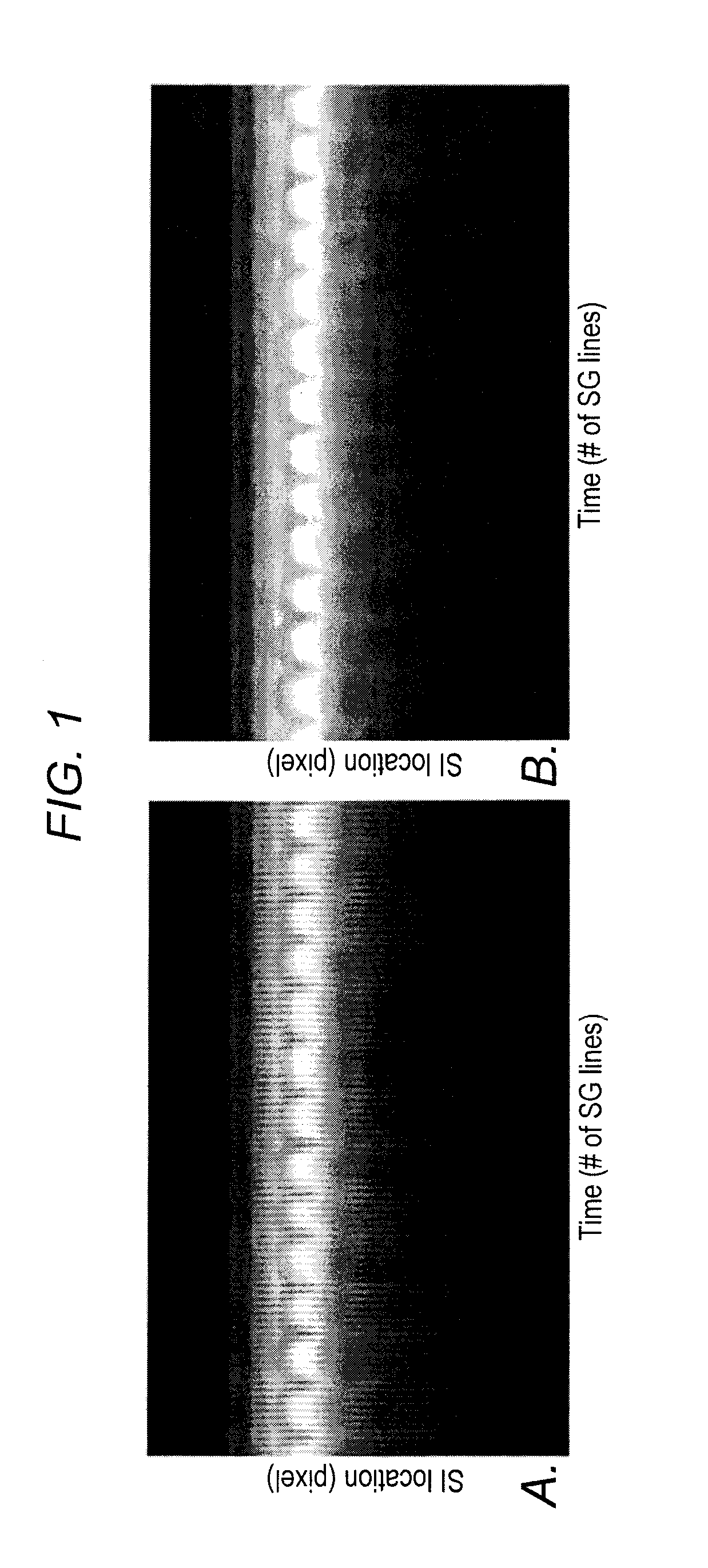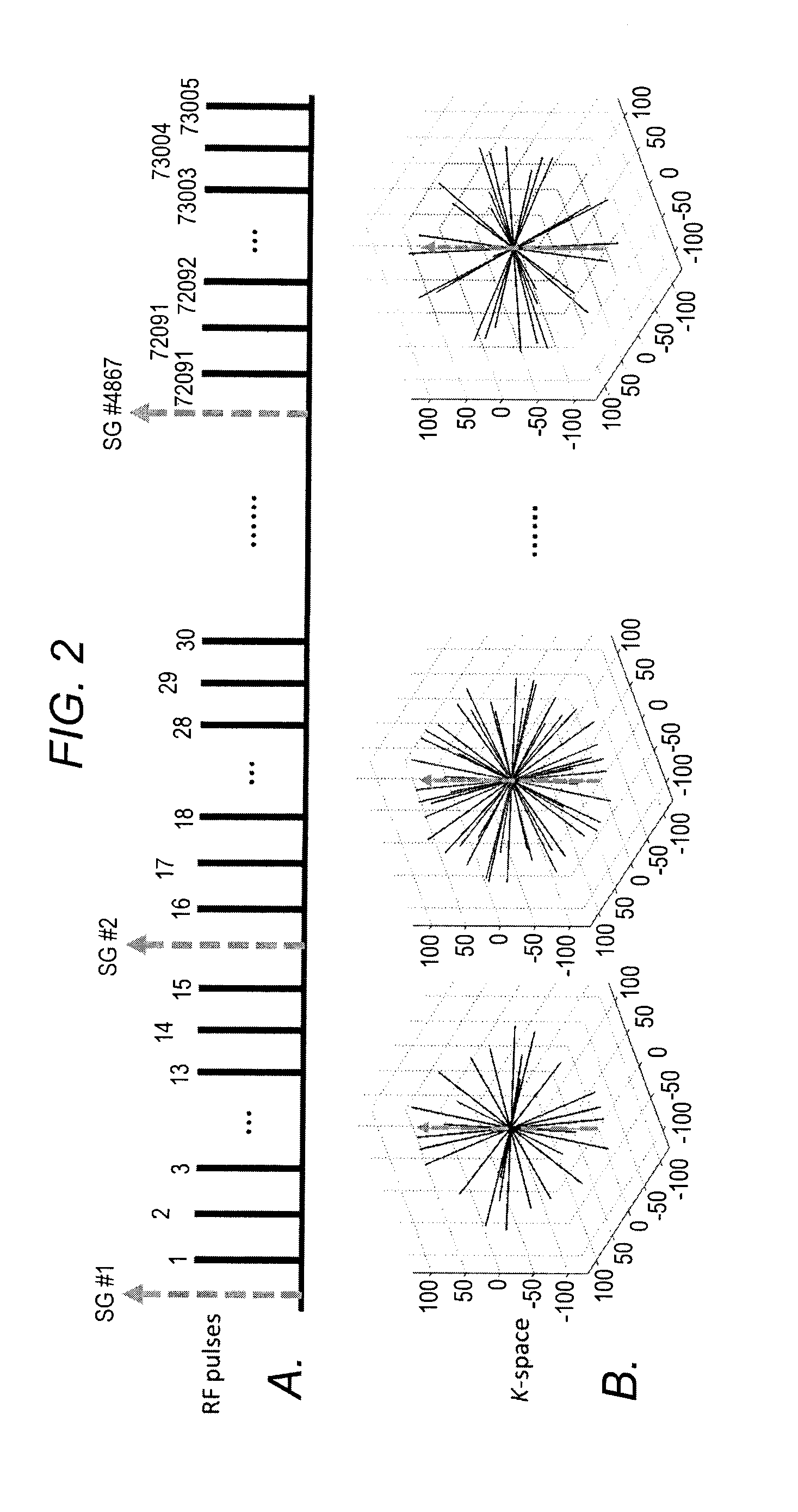Characterization of respiratory motion in the abdomen using a 4d MRI technique with 3D radial sampling and respiratory self-gating
a motion and abdominal organ technology, applied in the field of imaging methods and systems, can solve the problems of poor treatment outcomes, under-dosage in tumors and/or over-dosage in healthy tissues, and respiratory motion in abdominal organs poses significant challenges to accurate determination of treatment margins for target tumors
- Summary
- Abstract
- Description
- Claims
- Application Information
AI Technical Summary
Benefits of technology
Problems solved by technology
Method used
Image
Examples
example 1
Methods
[0037]A spoiled gradient recalled echo (GRE) sequence with 3D radial-sampling k-space trajectory and one-dimensional (1D) projection-based SG was implemented at 3.0 T for image acquisition (see Pang J, Sharif B, Fan Z, Bi X, Arsanjani R, Berman D S, Li D. ECG and navigator-free four-dimensional whole-heart coronary MRA for simultaneous visualization of cardiac anatomy and function. Magn Reson Med 2014, which is incorporated herein by reference in its entirety as though fully set forth).
[0038]In an attempt to preserve the sampling pattern stability required for arbitrary retrospective data sorting, the 3D radial k-space was filled using the 2D golden means ordering (see Chan RW, Ramsay E A, Cunningham C H, Plewes D B. Temporal stability of adaptive 3D radial MRI using multidimensional golden means. Magnetic Resonance in Medicine 2009; 61:354-363, which is incorporated herein by reference in its entirety as though fully set forth), a generalization of the origina...
example 2
Experiments
[0047]The feasibility of the technique was demonstrated with motion phantom studies and in-vivo liver imaging studies. All scans were performed on a clinical 3.0 T MRI system (MAGNETOM Verio, Siemens Healthcare, Erlangen, Germany) equipped with a 32-channel receiver coil (Invivo, Gainesville, Fla., USA).
Study Design
[0048]Schematics of the motion phantom are shown in FIG. 4a. A commercial Dynamic Breathing Phantom (RSD™, Long Beach, Calif., USA) system placed outside the scanner room was used to produce simulation signals that mimic the human respiratory motion. Through an air pump and tube, the signals were used to drive a plastic box (35×40×63 mm3) fully filled with gadolinium-doped water and sealed with silicone sealant. Five PinPoint® fiducial markers (Beekley Medical™, Bristol, Conn., USA) were placed on each face of the box. The box was then used as an imaging target, where reciprocating motion was executed along the z-axis of the magnet at a frequency of 18 cycles / m...
example 3
Results
[0058]The SI motion of the imaging targets was well appreciated on the SG-derived respiratory curves. As expected, the motion phantom showed a strictly sinusoidal respiratory pattern and the human subjects, as illustrated in FIG. 3a (a healthy subject) and FIG. 3b (a patient), showed variations in breathing amplitude and frequency, with the patient showing more irregularity than the healthy volunteer. The retrospective data sorting strategy described in the examples above detected the breathing cycles with abnormal respiratory durations (rectangles on the zoom-in respiratory curve in FIG. 3) or expiratory peaks (vertical ovals) and also identified the outlier with large respiratory phase drift (horizontal oval). As a result, 5-16% of the total k-space data were discarded, with approximately 6000-7000 imaging lines available in each respiratory phase for image reconstruction.
[0059]The method in the non-limiting example set forth above offered respiratory phase-resolved volumet...
PUM
 Login to View More
Login to View More Abstract
Description
Claims
Application Information
 Login to View More
Login to View More - R&D
- Intellectual Property
- Life Sciences
- Materials
- Tech Scout
- Unparalleled Data Quality
- Higher Quality Content
- 60% Fewer Hallucinations
Browse by: Latest US Patents, China's latest patents, Technical Efficacy Thesaurus, Application Domain, Technology Topic, Popular Technical Reports.
© 2025 PatSnap. All rights reserved.Legal|Privacy policy|Modern Slavery Act Transparency Statement|Sitemap|About US| Contact US: help@patsnap.com



